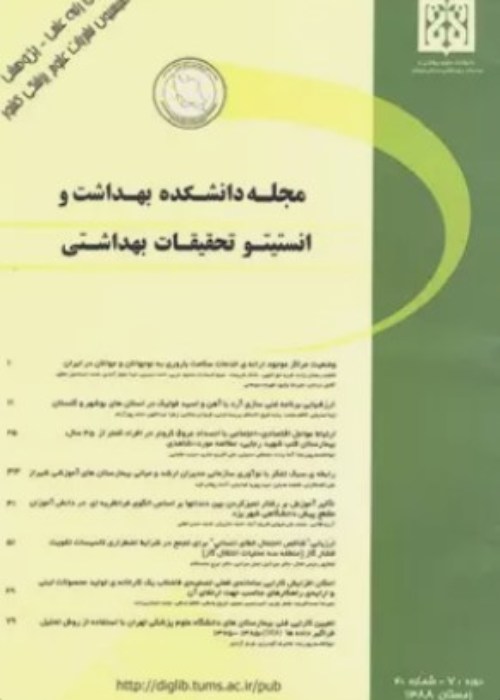Relative frequency of animal rabies and factors affecting it in Kerman province, 1993 - 2003
Author(s):
Abstract:
Background And Aim
Rabies is one of the oldest and most serious zoonoses in the world. In Iran, the disease has been reported from most of the provinces and among domestic as well as wild animals. This study was conducted in the province of Kerman and aimed to assess the frequency and epidemiological features of suspected and confirmed animal rabies cases from 1993 to 2003.Material And Methods
During the study period, all cases of suspected animals (brain specimens) had sent to Pasteur institute of Iran for pathological (Negri bodies) examinations. After collecting data on variables such as species of animal, city, season, annual rainfall and temperature, analysis was performed by calculation of Pearson correlation coefficient and Chi square, Fisher's exact, Students's t and Kolmogorov Smirnov tests using the SPSS package (ver.11.5). Results
From 362 suspected brain samples, 301 (83.1%) had positive serologic and pathological results. We recorded an ascending trend over the study period (p=0.01). The effect of seasonal variations on the frequency of suspected and confirmed cases of animal rabies was significant (p<.001): most cases occurred in winter and fall. The relative frequencies of confirmed cases among the animals were as follows:As for domestic animals, the infection rate in cows was 81.45 %; sheep and goats 10.63%; dogs and cats, 4 %; camels 1.33% and donkeys, 0.7%. Among wild animals (foxes, mongooses, wolves and jackals) the rate was 1.89%. Among wild animals, the total infection rate was 60 %. Concerning the role of predatory animals in the transmission of rabies to domestic animals, among the cases which had been confirmed (28 cases), the predator species were: foxes 50%, wolves 7%, mongooses and jackals 3%. Considering the relationship between frequency of animal rabies and ecological variations in the province of Kerman, the results of this survey showed that there is some correlation between decreased rainfall (drought) and the resurgence of animal rabies (r=0.34, P=0.001).Conclusion
The increasing number of stray dogs and the migration of these and wild animals to cities and villages could be an important factor in the spread of rabies in the region. Among various predatory species, the role of foxes in disease transmission merits further investigation.Language:
Persian
Published:
Scientific Journal of School of Public Health and Institute of Public Health Research, Volume:5 Issue: 1, 2007
Pages:
69 to 76
magiran.com/p456322
دانلود و مطالعه متن این مقاله با یکی از روشهای زیر امکان پذیر است:
اشتراک شخصی
با عضویت و پرداخت آنلاین حق اشتراک یکساله به مبلغ 1,390,000ريال میتوانید 70 عنوان مطلب دانلود کنید!
اشتراک سازمانی
به کتابخانه دانشگاه یا محل کار خود پیشنهاد کنید تا اشتراک سازمانی این پایگاه را برای دسترسی نامحدود همه کاربران به متن مطالب تهیه نمایند!
توجه!
- حق عضویت دریافتی صرف حمایت از نشریات عضو و نگهداری، تکمیل و توسعه مگیران میشود.
- پرداخت حق اشتراک و دانلود مقالات اجازه بازنشر آن در سایر رسانههای چاپی و دیجیتال را به کاربر نمیدهد.
In order to view content subscription is required
Personal subscription
Subscribe magiran.com for 70 € euros via PayPal and download 70 articles during a year.
Organization subscription
Please contact us to subscribe your university or library for unlimited access!


